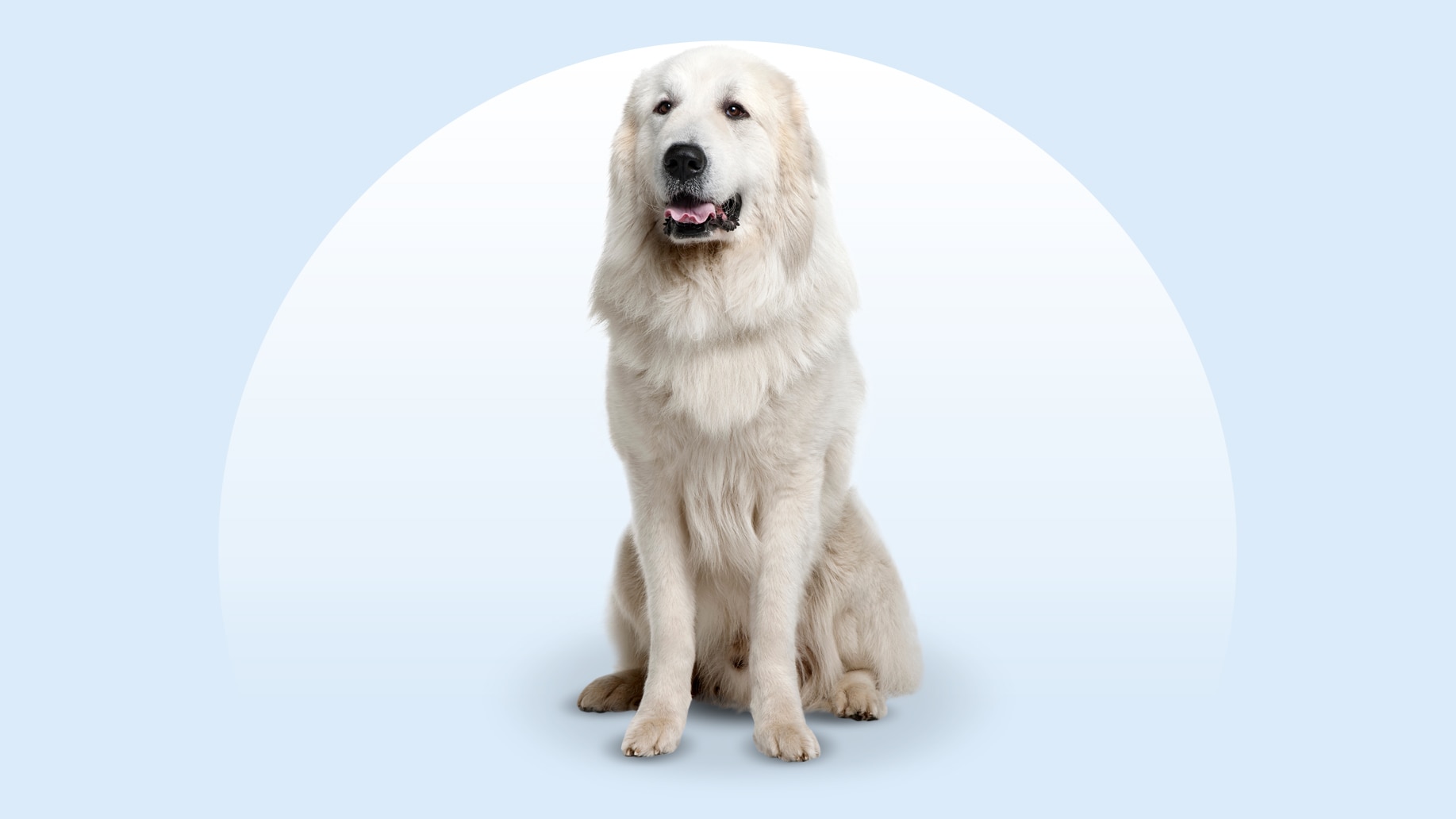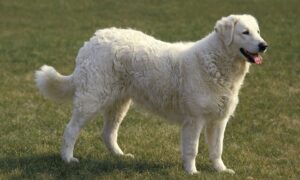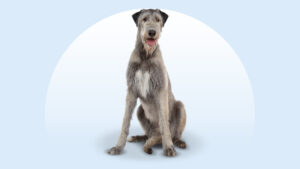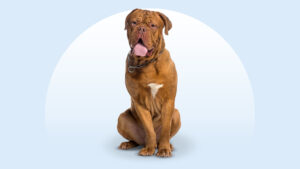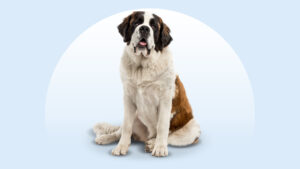Great Pyrenees
Updated June 4, 2025
Great Pyrenees
Updated June 4, 2025
The Great Pyrenees is a majestic giant with origins in the snowy Pyrenees Mountains. These kind, gentle dogs are known for their fluffy white coat, larger-than-life size, and cool demeanor. They’re super devoted pups who thrive in calm homes with plenty of space to spread out and roam.
Confident, Serene, Smart
85 pounds and up
25–32 inches
10–12 years
White
Have you ever done a double-take and wondered if a polar bear just moved into your neighborhood? It was probably just a Great Pyrenees.
A Pyr, as they’re sometimes called, is the kind of pup who looks like they were made for après-ski: Just picture them lying by a roaring fireplace with snow falling outside while you sip a hot cider and cuddle up by their furry side. But no matter the weather, these happy, gentle mountain dogs are devoted best friends all year round, and they make great family pets, too.
Great Pyrenees Characteristics
Great Pyrenees Appearance
With their bright white coat and large frame, a Great Pyrenees has a striking appearance. They have a rounded head, intelligent brown eyes, a quiet gaze, a lot of fur, and a feathery tail.

- Ears
Great Pyrenees ears are V-shaped, small to medium in size, and rounded at the tips.
- Eyes
Great Pyrenees eyes are almond-shaped, a medium size, and dark brown.
- Nose
A Great Pyrenees nose is black and round.
- Coat Length
As mountain dogs, Great Pyrenees sport a thick double coat consisting of two parts: a long, flat outer coat and a dense, wooly undercoat. More abundant fur grows around the neck and shoulders in males to form a ruff or mane.
- Coat Color
Great Pyrenees are either all white or white with some markings in reddish brown, badger (markings that fade as they age), tan, or gray.
- Tail
A Great Pyrenees’ tail has longer hair than the rest of their body and forms a plume.
Great Pyrenees Temperament
Patient and affectionate, Great Pyrenees are generally friendly and well-suited to family life. They’ll get along well with kids if children are taught to respect your dog’s space, and Pyrs are likely to do well with cats, dogs, and other animals, too (their ancestors spent all that time hanging out with sheep, after all).
Even though Great Pyrenees are known for their gentleness, their origins as a guardian dog back in the day mean that they can have a mind of their own, so early training and socialization is essential.
Their guardian dog legacy also left them with a high level of patience; this pup’s ancestors were accustomed to the slow pace of watching sheep for hours, and years later, that nugget of patience still lies within their soul. But that doesn’t mean they won’t bark; in fact, this wise soul will try to tell you what’s happening around the house and the neighborhood.
Despite any noisemaking, the serene Great Pyrenees enjoys a quiet home life (perfect for pet parents who appreciate evenings in front of the TV or with a good novel). Of course, exercise is a nonnegotiable—so like your pup, you’ll need to enjoy some activity, too.
How to Care for a Great Pyrenees
Grooming a Great Pyrenees dog is less intense than you might think. But you do need to spend extra time on training and socialization, make sure they get daily exercise, and give them enough room to roam.
Grooming
Training
Diet
Exercise
Environment
Great Pyrenees Health
The typical Great Pyrenees lifespan is 10–12 years, but there are some health issues to be aware of.
- Bloat and gastric dilatation-volvulus (GDV): Great Pyrenees, like many large, deep-chested breeds, are prone to a condition called bloat, when the stomach fills with air or food. A life-threatening complication of bloat is GDV, when the stomach twists on itself and cuts off blood supply to the organs. Symptoms include abdominal distension, restlessness, excessive drooling, and dry heaving. If you notice these signs, go to the vet immediately.
- Deafness: Congenital deafness can appear in any breed, but it’s more prevalent in dogs with white skin and fur, like the Great Pyrenees. While there’s no cure for this condition, deaf dogs can do well in calm homes.
- Eye issues: There are several eye conditions that Great Pyrenees dogs can develop.
- Canine multifocal retinopathy is a genetic eye disease that can lead to vision loss.
- Cataracts in dogs look like an opaque lens in the eye and may cause blindness, but surgery can remove them.
- Entropion is when the eyelid grows inward, causing the eyelashes to rub against the cornea, causing ulcers; surgery may be needed to correct it.
- Hip and elbow dysplasia: Common in large breeds, dysplasia is where the joints don’t fit together properly, whether it’s the hip or elbow. Treatment may include weight management, joint supplements, pain medication, physical therapy, and/or surgery.
- Luxating patella: In dogs with a luxating patella, the kneecap can pop out of place, resulting in lameness, pain, and eventually arthritis. Surgery is needed in severe cases.
- Neuronal degeneration (NDG): NDG is a genetic disorder that causes changes to your dog’s nervous system and eventually makes it difficult for pups to have control over their movements. Symptoms can include a loss of coordination, slipping or sliding in the hind legs, and falling. There is no cure or treatment, although genetic screening testing is available for Great Pyrenees puppies.
Great Pyrenees History
The Great Pyrenees has roots in the Pyrenees Mountains that divide France and Spain. Their lineage is ancient—their origins have been traced back as far as the Bronze Age, or 1800 to 1000 B.C.E.
Originally bred to herd and guard sheep and other animals, Great Pyrenees were eventually embraced by French royals and the noble class, who put them to work as guardian dogs in castles in southwest France. King Louis XIV even bestowed the special moniker “Royal Dog of France” upon the Great Pyrenees breed.
England’s Queen Victoria also had a Great Pyrenees, and French military officer the Marquis de Lafayette, who served alongside George Washington during the American Revolution, brought the breed to the U.S.
Recognized by the American Kennel Club in 1933, today’s Great Pyrenees are valued family members, though they’re still sometimes found working on farms.
Great Pyrenees puppies cost anywhere from $1,750–$2,500 or more. If you choose this route, pick a responsible breeder.
You can also adopt a Great Pyrenees dog. To find your best buddy, look for a Great Pyrenees rescue like National Pyr Rescue, keep an eye out for the breed at your local animal shelter or on their social media, or search Chewy’s database of adoptable dogs in your area.
